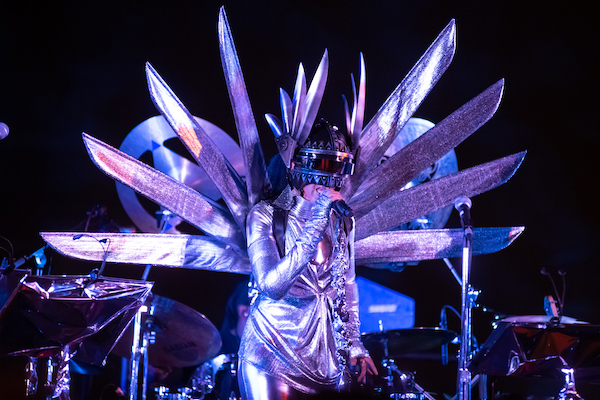Oct 28, 2025 10:47 AM
In Memoriam: Jack DeJohnette, 1942–2025
Jack DeJohnette, a bold and resourceful drummer and NEA Jazz Master who forged a unique vocabulary on the kit over his…

Vocalist Nona Hendryx performs Feb. 29 during Nona Hendryx and Disciples of Sun Ra in the Temple, an event celebrating the bandleader and keyboardist, which was held in the Sackler Wing of New York’s Metropolitan Museum of Art.
(Photo: Paula Lobo)Vocal doyen Nona Hendryx commanded the stage at New York’s Metropolitan Museum of Art on Feb. 29, bedecked in a silver, winged spacesuit and dark helmet. “Welcome to this Afrofuturistic-cala-fragilistic evening,” she told the crowd that assembled for “Nona Hendryx and Disciples of Sun Ra in the Temple.” “We are here to honor Sun Ra.”
Hendryx offered this introduction just after the first selection, an expansive medley of the visionary composer’s music, including the propulsive “Rocket Number Nine Take Off For The Planet Venus” and a ballad rendition of “The Sky Is A Sea Of Darkness When There Is No Sun.” On the latter song, Hendryx’s ardent free-vocals and the resounding rock groove left no question about the event’s message: Sun Ra’s music is serious listening.
Regardless, there was no ignoring the multisensory pageantry of Hendryx’s production: the swirling lights, Afrodiasporic costumes, expressive dancers and about a dozen improvising musicians on the bandstand. In the Sackler Wing of the museum no less, right in front of the mythic, hieroglyph-covered Temple of Dendur, an ancient edifice that two millennia ago stood on the banks of the Nile. A perfect setting for a Sun Ra retrospective.
If the Sackler Wing was the right space for the event, Hendryx was the ideal artist at its helm. Not only has she taken on multiple musical personalities during her five-decade career, but in her role as artistic director for Harlem Stage, she has the resources to craft a fitting tribute to Sun Ra’s musical ingenuity.
“My work with [vocal trio] Labelle and others has involved not only elements taken from the creativity of the African diaspora, but from technology, science and fiction. My moving through those worlds is how [this project] started,” she said in a recent phone interview. “Then [Harlem Stage Executive Director Patricia Cruz and Director of Programming Monique Martin] were talking about collaborating with larger institutions, and it seemed that there was a perfect storm. Many institutions were wanting to explore Afrofuturism.”
For the uninitiated, “Afrofuturism is the synthesis of the African aesthetic and history, seen through the lens of science and technology,” she continued. “It’s about being able to express yourself from a historic view and have an ability to see an African-inspired influence in the future.”
In 2019, Harlem Stage brought Hendryx on specifically to curate its yearlong initiative on the topic, “The Cosmic Synthesis of Sun Ra and Afrofuturism.” This series of public events “pays tribute to the work of the jazz legend Sun Ra in imagining a black future, even when society said there wasn’t one,” Cruz wrote in an email.
Sun Ra, born Herman Poole Blount (1914–93), is credited as a leading pioneer of Afrofuturism, though the term itself didn’t take hold until after his death. That said, his midcentury musical experiments at the intersection of space mythology and the African experience laid the groundwork for ongoing Afrofuturistic expressions across all manner of artistic and media platforms.
Increasingly, Afrofuturism is gaining a foothold in the popular culture: “I think the thing that really triggered a lot of interest in [Afrofuturism] around the world was the movie Black Panther,” Hendryx said.
The film shows a black superhero navigating a high-tech world, his identity firmly planted in the fictional African nation of Wakanda. As a symbol of that past, Senegalese griot singer Baaba Maal’s throaty vocals punctuate the film’s Oscar-winning score.
Hendryx seems to understand the power of these sorts of aesthetic statements. In recontextualizing Sun Ra’s compositions, for instance, she enhanced the connection between the African diaspora and an imagined future: Her version of Sun Ra’s tongue-in-cheek composition “Enlightenment”—a musical invitation to join his “space world”—was a boisterous reggae tune, with a chorus of vocalists and an overlay of reverberating spoken word.
Taken together, “The Sky Is A Sea of Darkness When There Is No Sun” and “Enlightenment” formed the first and second pillars of the evening’s performance—key touchpoints for the audience experience. “You have light first and then enlightenment,” Hendryx pointed out. “And then ‘Space Is The Place.’ That’s the last pillar.”
One of Sun Ra’s better-known tracks, “Space Is The Place,” celebrates the freedom of an extraterrestrial existence—especially for those of African American descent. In her take of the tune at the museum, Hendryx opted for more accessible harmonic conventions and fewer noisy accoutrements that characterized the original. A good call: In the final moments of the concert, the audience felt moved to clap in time and sing along.
Hendryx likely wasn’t surprised by this spontaneous response to her finale. “We are frequencies; we vibrate. And when we are doing music together, we’re vibrating together,” she said. “It’s one of the most beautiful things that we as humans can do.” DB

Jack DeJohnette boasted a musical resume that was as long as it was fearsome.
Oct 28, 2025 10:47 AM
Jack DeJohnette, a bold and resourceful drummer and NEA Jazz Master who forged a unique vocabulary on the kit over his…

D’Angelo achieved commercial and critical success experimenting with a fusion of jazz, funk, soul, R&B and hip-hop.
Oct 14, 2025 1:47 PM
D’Angelo, a Grammy-winning R&B and neo-soul singer, guitarist and pianist who exerted a profound influence on 21st…

To see the complete list of nominations for the 2026 Grammy Awards, go to grammy.com.
Nov 11, 2025 12:35 PM
The nominations for the 2026 Grammy Awards are in, with plenty to smile about for the worlds of jazz, blues and beyond.…

Jim McNeely’s singular body of work had a profound and lasting influence on many of today’s top jazz composers in the U.S. and in Europe.
Oct 7, 2025 3:40 PM
Pianist Jim McNeely, one of the most distinguished large ensemble jazz composers of his generation, died Sept. 26 at…

Drummond was cherished by generations of mainstream jazz listeners and bandleaders for his authoritative tonal presence, a defining quality of his style most apparent when he played his instrument unamplified.
Nov 4, 2025 11:39 AM
Ray Drummond, a first-call bassist who appeared on hundreds of albums as a sideman for some of the top names in jazz…






